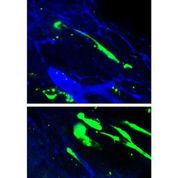Growing Lymph Vessels in a Lab
Technion scientists have succeeded in producing an engineered lymph vessel network, opening path to novel lymphedema treatment


Technion scientists have managed to grow an engineered human lymphatic vessel network. Published in PNAS, the study was led by postdoctoral fellow Dr. Shira Landau and conducted in the laboratory of Professor Shulamit Levenberg of the Technion Faculty of Biomedical Engineering. The significance of the researchers’ findings lies in a better understanding of lymphatic vessel generation, which could have implications for treatment of lymphedema and the generation of more lifelike tissue flaps.
The lymphatic vessels are built similar to veins. They collect the fluid between the cells in all body tissues. This lymphatic fluid is collected by lymph capillaries, then transported via progressively larger lymphatic vessels through lymph nodes, before emptying ultimately into major veins. The lymphatic system also plays an important role in the body’s immune response. Damage to the lymphatic vessels results in localised swelling, a condition called lymphedema. Lymphedema currently has no cure. Common treatments that provide partial improvement include compression of the affected limb and massage. In severe cases, bypass surgery is prescribed.

This success by the Technion scientists has multiple implications. First, the platform they grew would facilitate the study of lymphatic vessels, their formation, and the factors that affect them. Second, lymphedema, which currently lacks effective treatment, could be in the future treated by implanting a functional network of smaller and larger lymph vessels that would merge with the host’s system, all grown from the patient’s own cells, eliminating fear of rejection. Third, engineered tissue flaps, that is units containing multiple tissues necessary for transplantation, such as muscle, blood vessels, and connective tissue, could be made more lifelike, containing lymph vessels as well. This would improve the implant’s integration and speed up healing.
Click here for the paper in PNAS

